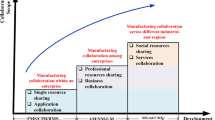Abstract
The paper analyzes the Electrical Manufacturing Services (EMS) industry’s current status in China, introduces a value stream mapping (VSM) collaboration tool which brings solid working process with agile information flow, and builds a theoretical foundation with a new management concept for China EMS to promote its integrated core competencies and to increase the market returns. VSM collaboration tools can be used across the electronics industry and other industries; it provides EMS the strategic advantages of a flexible, reactive system that agilely adapts to customers’ real-time needs, and builds EMS high profile with core competencies of being a strategic world-class performer.
Similar content being viewed by others
References
Ashkenas R, Ulrich D, Jick T, Kerr S (1995) The boundaryless organization: breaking the chains of organizational structure. Jossey-Bass, San Francisco
Barbalho M, Dunn S, Colabello V (1998) The globalization of logistics. Manuf Syst 16:132–141
Bhatnagar R, Chandra P, Goyal SK (1993) Models for multi-plant coordination. Eur J Oper Res 67:141–160
Custer W (2006a) BELM research note. Custer Consulting Group, The Sea Ranch, CA, USA. http://www.custerconsulting.com
Custer W (2006b) Business outlook. Custer Consulting Group, The Sea Ranch, CA, USA. http://www.custerconsulting.com
Fisher M (1997) What is the right supply chain for your product. Harv Bus Rev 75(2):105–116
Garavelli AC (2003) Flexibility configurations for supply chain management. Int J Prod Econ 85(2):141–153
Hall RW (1983) Zero inventories. Dow Jones-Irwin, Home-wood, IL
Hameri A-P, Paatela A (2004) Supply network dynamics as a source of new business. Int J Prod Econ 98:41–55
Heikkilä J (2002) From supply to demand chain management: efficiency and customer satisfaction. J Oper Manage 20(6):747–767
Holmström J, Framling K, Kaipia R, Saranen J (2002) Collaborative planning forecasting and replenishment: new solutions needed for mass collaboration. Supply Chain Manage 7(3/4): 136–145
Hopp WJ, Spearman ML (1996) Factory physics: foundations of manufacturing management, Irwin/McGraw-Hill, Burr Ridge, Irwin
Lee HL, Padmanabhan V, Whang S (1997) Information distortion in a supply chain: the bullwhip effect. Manage Sci 43(4):546–558
Magsaysay J (2006) Forming 3A supply chain. Global Sources, World Executive’s Digest Ltd. Crand Cayman, Cayman Islands, pp 64–68
Michael EP (1985) Competitive advantage. The Free Press, New York, pp 57–60
Michael G (1989) Diversification and integration in American industry [M]. Princeton University Press, Princeton
Monden Y (1983) The Toyota production system. Productivity Press, Norcross, GA
Morgan Stanley Research (2006) Flextronics, at the inflection point, industry view. Morgan Stanley & Co. Incorporated
Schilling M (2000) Toward a general modular systems theory and its application to inter-firm product modularity. Acad Manage Rev 25(2):312–335
Schonberger RJ (1982) Japanese manufacturing techniques: nine hidden lessons in simplicity. The Free Press, New York
Suri R (1998) Quick response manufacturing. Productivity Press, Portland, OR
Walton LW (1996) Partnership satisfaction: using the underlying dimensions of supply chain partnership to measure current and expected levels of satisfaction. J Bus Logist 17:57–75
Wenzek H (2005) Rewiring electronics: discovering strategies for sustainable growth from a business ecosystem perspective. IBM Business Consulting Services, P10–11
Williams T, Maull R, Ellis B (2002) Demand chain management theory: constraints and development from global aerospace supply webs. J Oper Manage 20(6):691–706
Womack JP, Jones D (1996) Lean thinking. Simon & Schuster, New York
Womack JP, Jones DT, Roons D (1990) The machine that changed the World. Rawson Associates, New York
www.12manage.com (2006) Value chain framework. 12manage on-line information. http://www.12manage.com
Author information
Authors and Affiliations
Corresponding author
Rights and permissions
About this article
Cite this article
Shen, S.X., Han, C.F. China electrical manufacturing services industry value stream mapping collaboration. Int J Flex Manuf Syst 18, 285–303 (2006). https://doi.org/10.1007/s10696-007-9016-6
Received:
Accepted:
Published:
Issue Date:
DOI: https://doi.org/10.1007/s10696-007-9016-6




